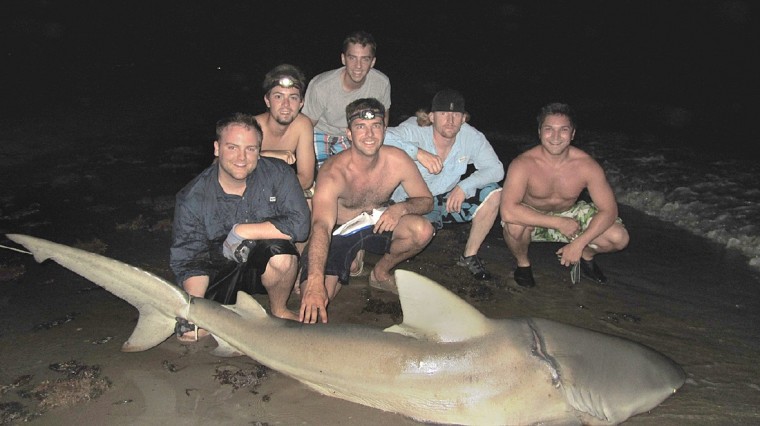A bachelor party on the shores of High Island in Galveston County over the weekend brought in several big sharks for the group, including two Montgomery County men.
But the biggest catch of the weekend landed a bull shark not far off the state record of 9 feet, 515 pounds, listed on the Texas Parks and Wildlife website, said Zachary Seltz, of Houston.

Seltz and the group , John Indellicati, of Magnolia, Kevin Bass, of The Woodlands, Landon Lucadou, of College Station, Pete Burgess, of Houston, Monty Seltz, of Houston, Nathan Wolford, of Houston, and Pete Stewart, of Illinois – set up camp on High Island Friday night with their rods and reels set for action, Zachary Seltz said.
“The waves weren’t too bad, but the current was bad and the seaweed was bad,” said Seltz, who is getting married this weekend.
In fact, the group caught mostly seaweed until Lucadou landed a 5-foot, 4-inch bull shark.
“That got morale back up,” Seltz said.
Seltz caught a 5-foot, 6-inch bull shark early Saturday morning, and the group went into its rental beach house to sleep, getting back up to resume fishing around 11 a.m., he said.
The men caught several more sharks, including a couple of blacktips, throughout the day. Then, sometime before 2 a.m. Sunday, a rod attached to an Avet 50 EWX reel with 100-pound line “goes off streaming,” Seltz said.
The 8-foot, 9-inch bull shark hooked to the line “blitzed” off, Seltz said, taking 75 yards of line with it, he said. Seltz handed the rod and reel to Wolford, who wrestled with the shark about 15-20 minutes before he was able to haul it in.
“It was huge,” Seltz said. “It took four of us to drag it out of the water and two of us to put her back in.”
It’s common for female bull sharks to come into bays and drop their litters in estuaries, staying for awhile until all head out to sea, Seltz said. The big one Wolford hauled in had just dropped her pups, he said.
Bull sharks, which get their name from their snubnose snout and “pugnacious” reputation, occur in tropical to subtropical coastal waters worldwide, according to the Florida Museum of Natural History’s icthyology website at www.flmnh.ufl.edu.
“In reality,” the website states, “this species is likely responsible for many more, and has been considered by experts to be the most dangerous shark in the world.”
Because it would take severely injuring or killing the biggest shark to weigh it, Seltz said, the group doesn’t have an exact weight, although he estimates it to be about 350 pounds.
Seltz and his group released every shark caught during their outing.

“We use circle hooks (less likely chance of gut hooking and killing the fish), go out of our way not to cause any damage to these beautiful fish, we stay with them in the water reviving them til they swim off under their own power and follow them with flashlights/headlamps to ensure they made it out to sea past the waves,” he stated in an e-mail.
The group even performed a bit of surgery on the big shark to help it.
“It had a giant scar on it,” he said. “It had fishing line wrapped around it that was cutting through it. We pulled as much line out of it as we could and cut the line as close to the skin.
“She’s for the better.”
(SOURCE)